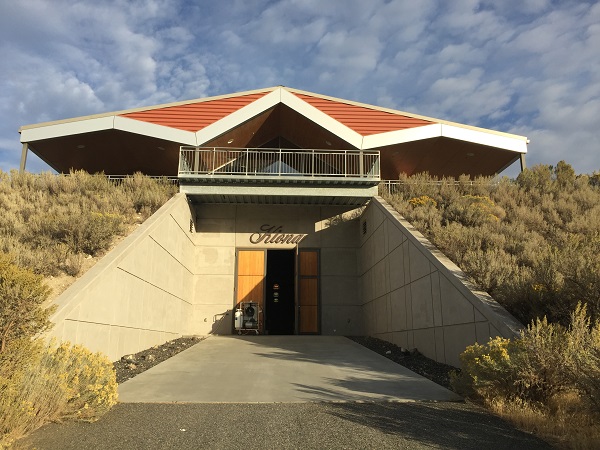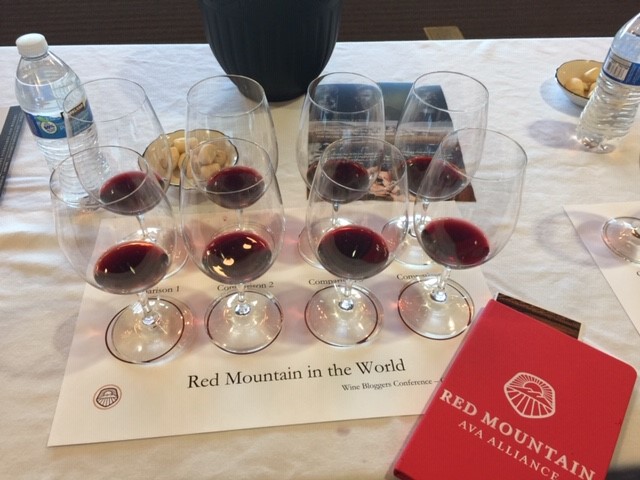|
|
In early October 2018 I attended the annual Wine Blogger’s Conference (WBC18), held in Walla Walla, Washington, hosted by Visit Walla Walla. In my last blog I talked about stepping foot into a California AVA that I had never been in, Edna Valley. After this latest wine adventure, I can now check off a few more AVAs from my wine bucket (should I say “barrel”?) list: Walla Walla, Red Mountain, Columbia Gorge, and Columbia Valley, in Washington and Oregon.
Every year I take advantage of the WBC pre-excusion, which affords me the opportunity to dive deep into a specific AVA, region, or winery for a couple days. This year I chose the Red Mountain AVA trip, as I was of the belief from working in wine retail that this was the one to know.
First of all, Red Mountain is neither a mountain nor red. The elevation is just over 1400 feet at its peak, and the drooping broom grass that once covered the hills — and which turns bright red at one point in the year — has been largely replaced with vines. Back before vineyards were planted, we were told that the region was a sea of brown with islands of green, but since vine plantings began in the mid 1970s, the better characterization is that the AVA is a sea of green with islands of brown. Most of Eastern Washington is basically a desert, with hot dry summers and cold winters, often with snow. Red Mountain comprises approximately 4,400 acres of land, of which 2,600 are planted to grapes (see the red dot on the map above). AVA status was reached in 2001. By any standards, this is a small AVA.
Day 1 of this excursion took us to Kiona Vineyards, from which many producers in Washington source their grapes. Here’s a better look at this iconic Red Mountain producer.
Kiona Wines
The aptly named Kiona vineyards (named 2018 Washington Winery of the Year by Winepress Northwest), translates to “brown dirt” in the local Indian language. JJ Williams, grandson of founder John Williams, was our affable host at the gorgeous, modern winery overlooking the vines. The Williams family owns 100% of their land, their grapes, and their wines; there are no outside investors, it’s all theirs. This is refreshing in an ever-diminishing wine world where big names own just about everything.
|
|
The Kiona vineyards were first planted in 1975, by John Williams (JJ’s grandfather) and his partner Jim Holmes, both former GE engineers. They planted 10 acres of Chardonnay, Riesling, and Cabernet Sauvignon, in equal amounts. Back in the mid-70s, says Williams, Red Mountain was considered a white wine region, contrary to what we know it as today. Williams and Holmes planted two sticks in each hole in the hopes that at least one would survive, but Williams’ grandfather fully expected about half the vines to live, and half to die, as this region can get very, very cold during the winter months. The diurnal temperature shift — that is, the swing from daytime high to nighttime low — is 40 degrees. Such a dramatic shift is good for grape ripening, allowing sugars to build up during the warm hours, and acid retention to occur in the cool hours. The partners went on to plant Lemberger, Chenin Blanc, and Merlot.
Kiona’s first grapes were crushed in 1978, from Cabernet Sauvignon and Merlot, revealing the richness, depth of color, and intensity that would go on to become the hallmarks of Red Mountain reds. These “diamonds in the rough” sealed the deal for Kiona; they knew their sweet spot was Bordeaux-style red wines, but they also saw promise over the years with other red varieties, particularly Syrah. However, the vast majority of Kiona’s plantings, nearly 68%, is Cabernet Sauvignon.
Holmes and Williams dissolved their partnership amicably in 1994, and the Holmes family now owns outright the acclaimed Ciel du Cheval vineyards adjacent to Kiona, which will be discussed in an upcoming posting.
Current red offerings from Kiona include their Red Mountain Reserve (a blend), RM Cabernet Sauvignon, Estate RM Merlot, RM Syrah and Estate RM Sangiovese and, interestingly, Estate RM Lemberger, the spicy dark red Austian grape known as Blaufrankisch, which is also grown in New York’s Finger Lakes region.
Whites are also on Kiona’s menu, using grapes from the much larger and less defined Columbia Valley AVA (see blue area in map above) and the winery’s current offerings include Chenin Blanc, Chardonnay, and Riesling, including a late-harvest version. Additional varieties grown, in small quantities, include Petit Verdot, Gewurtraminer, Carmenere, Petite Sirah, Mourvedre, Cabernet Franc, Malbec, Zinfandel, Viognier, and Roussanne.
Kiona has three Red Mountain estate vineyards — Kiona Estate, Ranch at the End of the Road, and Heart of the Hill — totaling about 240 acres, plus two additional Columbia Valley AVA vineards, Vista and Nine Canyon, just over 87 acres together. They sell their highly-prized grapes to over 50 producers in the area. If you get a bottle of Red Mountain wine from any producer, take a look at the label to see if the grapes come from Kiona.
|
|
Other characteristics of Kiona vineyards, and Red Mountain AVA, our tour guide pointed out to us are what he called its five pillars, which are:
- Slope — gentle and southwest facing
- Dryness — only 5.8 inches of rain per year, with winter and early spring the wettest. This allows Kiona to control how much water the grapes are getting, a good thing in vineyard management.
- Wind — they come up the valley in the morning, and down the valley in the evening. This helps thicken grape skins and reduce vine disease.
- Dirt — basic, with good drainage (more on dirt in a future posting)
- Heat units — being so far north, they get 16-17 hours of sunlight during the growing season.
Tasting Red Mountain
JJ Williams took us bloggers though an interesting exercise, comparing four Red Mountain Kiona vineyard wines (none were Kiona’s, which was a disappointment for me) with four old world wines (well, one was actually from Napa) to show us how Red Mountain wines are world class and can hold their own in a blind tasting.
|
|
All of the wines, which included Hedges Red Mountain 2015 (100% Syrah), Col Solare 2015 (100% Cabernet Sauvignon), Fidelitas 2015 (100% Cabernet Sauvignon), and Hightower 2014 (80% Cabernet, 10% each of Malbec and Merlot), were sampled blindly against, respectively, Chateau de Pez from St. Estephe in Bordeaux, Brancaia Supertuscan from Italy, Chappellet Cabernet from Napa Valley, and Hickenbothem Trueman Cabernet from McClaren Vale, Australia. The wines held their own and proved themselves to be worth exploring.
If you like big, bold reds, that are dark, stout, and powerful, with lovely ripe fruit and balancing acidity — a hallmark of Red Mountain grapes — then give these beauties a try.
Red Mountain’s Future
Additionally, there is no more space left for new plantings. What we saw on this trip is what visitors 20-30 years from now will see — it’s planted out. So this means vines will be ripped up to make way for new varieties, new clones, new experiments.
Thus far, Cabernet Sauvinon, Merlot, and Syrah seem to be king here. And no doubt in my mind, they are world-class.
Until next time, Cheers!




